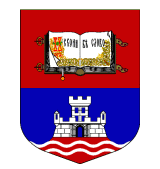Research in this area includes synthesis, characterization, and bioactivity analysis (inhibitory effect on parasites, viruses, bacteria, fungi, and cancers cells) of organic compounds and natural products; total and partial synthesis of natural products, synthetic methodology studies, synthesis of new heterocyclic compounds, and synthesis and characterization of fullerene-based nanosystems; chemotaxonomy studies, isolation and characterization of secondary metabolites of endemic plant species. In addition to experimental work, computational studies are performed: molecular modeling of systems, SAR, QSAR, QSRR, and QSPR studies, binding affinity prediction, and analysis of ligand-receptor interactions.
Researchers of the Department offer on-demand services including the development of new production procedures for opioid analgesics. An example of this practice is the synthetic procedure for fentanyl, developed for Galenika, and procedures for sufentanil, alfentanil, remifentanil, and carfentanil currently in development.
Research in this area is further subdivided to following segments:
- Synthesis and development of steroid and/or heterocyclic compounds with inhibitory activity against apicomplexan parasites, viruses, cancer cells, and botulinum toxin. In addition, research includes synthesis of heterocyclic compounds with antibacterial and antifungal properties and inhibitors of quorum sensing, and fungal and bacterial bio-films. Synthetic efforts focus on stereo- and chemoselective transformations of polyfunctional molecules. In vitro and in vivo testing of synthesized compounds takes place in cooperation with leading research centers locally and abroad. Supporting research activities include physico-chemical characterization of compounds using chromatography and computational modeling. Examples of analyses performed are studies of the effect of molecular structure on retention properties, determination of lipophilicity, use of multivariate chemometric techniques (PCA, MLR, PLS) for establishing molecular descriptors, analyzing interactions of compounds with plasma proteins, conformational analysis, 3D ADMET, and SAR modeling (QSAR, QSRR, and QSPR methods).
In our research, we collaborate with leading institutions, such as Walter Reed Army Institute of Research (WRAIR) Washington USA, U.S. Army Medical Research Institute of Infectious Diseases (USAMRIID), Frederick USA, National Institute of health (NIH-NCI) USA, National Institute of Allergy and Infectious Diseases (NIAID-TAACF) USA, University of Belgrade School of Medicine, Institute for Medical Research – University of Belgrade, Institute for Oncology and Radiology of Serbia, Institute for Oncology of Vojvodina – Sremska Kamenica, and the Institute of Molecular Genetics and Genetic Engineering – University of Belgrade. - Synthesis, pharmacological characterization, and computational analysis of GPCR ligands. This research is based on targeted synthesis of piperidine, 4-anilinopiperidine, phenanthrene, and arylpiperazine pharmacophore elements, with the ultimate goal of developing synthetic approaches for pharmaceutically relevant compounds, potential therapeutic agents for CNS disorders. Binding of ligands is estimated at various GPCRs (D2 dopaminergic, 5-HT1A and 5-HT2A serotonergic, and α1-adrenergic receptors) using competitive binding assays with radioactive standards ([3H]-spiperone, [3H]-8OH-DPAT, [3H]-ketanserin, and [3H]-prazosin). Receptors for the assays are isolated from rat synaptosomal membranes and CHO and CHO-K1 cell lines expressing hD2S and h5-HT1A receptors. Agonistic/antagonistic response of compounds is tested with a cAMP assay. In order to analyze ligand-receptor interactions and structure-activity relationships and support synthesis, computational methods are used, including docking, homology modeling, pharmacophore modeling, and molecular dynamics.
- Isolation and structural modification of natural products, mainly marine compounds. One research direction is the synthesis of quinone derivatives with improved bioactivity, through derivatization of natural products or design and synthesis of biomimetics. Upon synthesis, the compounds are tested for anti-tumor and antimicrobial activity, cell-cycle effects, and cytotoxicity. The research is supported by SAR studies. Mechanistic studies of bioactive quinones form an additional focus of our research. Redox properties and ROS-formation potential are tested alongside antioxidative and superoxide anion radical scavenging activity. Interactions of quinones with biomacromolecules in quinone-enzyme bioconjugates offer insight into transport and bioactivity of quinones after encountering hydrolytic enzymes.
Synthesis and chemical transformation of steroid compounds forms another segment of our research, focusing on oxidative and fragmenting transformations, introduction of heteroatoms, and functionalization of steroids (steroidal oximes, lactams, thiolactams and aza-steroids) in order to conduct SAR studies and improve biological activity. Research into thionation of α,β-unsaturated cholestane, androstane and pregnane steroid ketones using Lawesson’s reagent under thermal and microwave conditions has led to synthesis and characterization of organosulfur and organophosphorus steroid compounds. - Synthesis and physicochemical characterization of heterocyclic push-pull molecules. Heterocyclic push-pull molecules with a general formula of D--A feature strong donor-acceptor interactions and have interesting optical properties. Research in this area includes: synthesis and characterization of a series of 5-substituted and unsubstituted 4-oxothiazolidines with trisubstituted exocyclic double bond and examining the dynamics of chemoselective reactions involved, using precursors. 4-Oxothiazolidines are useful precursors in heterocyclic synthesis with some 2-alkyliden-4-oxothiazolidines registered as therapeutics. These derivatives feature delocalized charge and are ambidentate nucleophiles/electrophiles, facilitating their derivatization.
- Design and synthesis of small molecules with in vitro antitumor activity and selectivity, choline esterase inhibitors, carboanhydrase inhibitors, and inhibitors of multidrug-resistant bacterial strains. In silico design is based on molecular field descriptors, descriptors based on time-dependent conformational changes and ligand-receptors interactions analysis from molecular dynamics and docking. Physical organic chemistry and physicochemical profiling of synthetized bioactive compounds (determining ionization constants, solubility, logP, interactions with biologically relevant metal ions and plasma proteins) form additional facets of our research.
Research in this area is conducted in collaboration with: School of Life and Medical Sciences, University of Herdforshire, UK; Drug Design Laboratory, Faculty of Pharmacy, University of Milan, Italy; National Cancer Institute-Frederick, Maryland, USA; National and Kapodistrian University of Athens, Greece; Neurofabra Department, University of Florence, Italy; Scientific Computing Laboratory – Institute of Physics, Belgrade; Institute for Oncology and Radiology of Serbia; Military Technical Institute, Belgrade. - Design, synthesis, structural characterization, and analysis of properties of mono- and bis-functionalized derivatives of fullerene C60, with the view of incorporation into subunits of nano-molecular machines. Research in this area includes: synthesis of fulleropyrrolidine conjugates with steroids and peptides and characterizing their antioxidative activity and supramolecular organization, structural modifications of steroids to create stoppers for rotaxanes, synthesis of rotaxanes from fullerene and steroid elements and studying the properties of these topologically locked molecules (inter- and intramolecular noncovalent supramolecular interactions and mobility or rotaxane components under different conditions), and regioselective double cycloaddition to C60, guided by variously bridged diglycinates and characterization of obtained bridged bis-fulleropyrrolidines.

